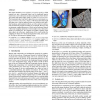Free Online Productivity Tools
i2Speak
i2Symbol
i2OCR
iTex2Img
iWeb2Print
iWeb2Shot
i2Type
iPdf2Split
iPdf2Merge
i2Bopomofo
i2Arabic
i2Style
i2Image
i2PDF
iLatex2Rtf
Sci2ools
SIGGRAPH
1999
ACM
1999
ACM
Environment Matting and Compositing
This paper introduces a new process, environment matting, which captures not just a foreground object and its traditional opacity matte from a real-world scene, but also a description of how that object refracts and reflects light, which we call an environment matte. The foreground object can then be placed in a new environment, using environment compositing, where it will refract and reflect light from that scene. Objects captured in this way exhibit not only specular but glossy and translucent effects, as well as selective attenuation and scattering of light according to wavelength. Moreover, the environment compositing process, which can be performed largely with texture mapping operations, is fast enough to run at interactive speeds on a desktop PC. We compare our results to photos of the same objects in real scenes. Applications of this work include the relighting of objects for virtual and augmented reality, more realistic 3D clip art, and interactive lighting design. CR Categ...
Computer Graphics | Environment Compositing Process | Foreground Object | SIGGRAPH 1999 | Traditional Opacity Matte |
| Added | 03 Aug 2010 |
| Updated | 03 Aug 2010 |
| Type | Conference |
| Year | 1999 |
| Where | SIGGRAPH |
| Authors | Douglas E. Zongker, Dawn M. Werner, Brian Curless, David Salesin |
Comments (0)

